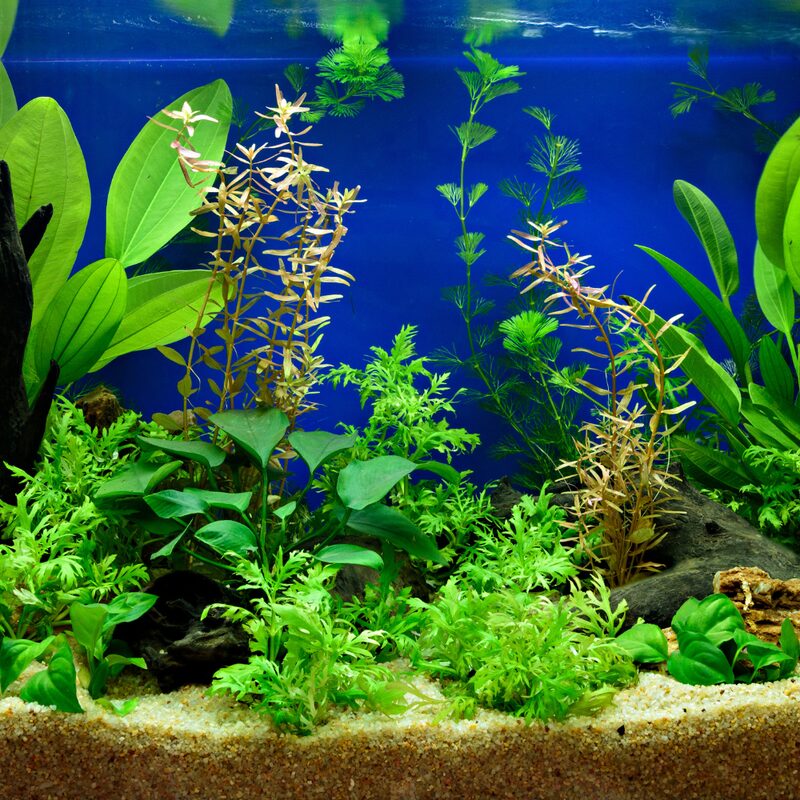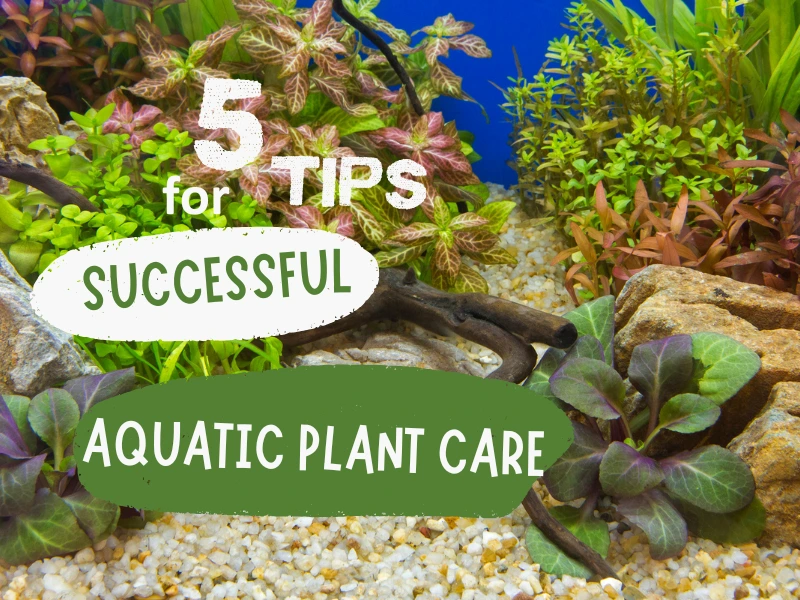-
×
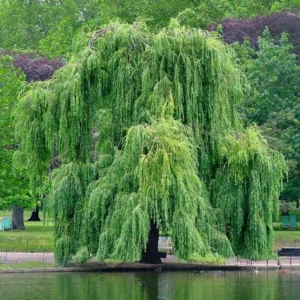 12 Weeping Willow Tree Cuttings, Hardy Willow Tree for Planting, Unrooted Cuttings
$23.99
12 Weeping Willow Tree Cuttings, Hardy Willow Tree for Planting, Unrooted Cuttings
$23.99 -
×
 Ice Cream Banana Tree, Blue Java Banana, 4-6" Bareroot Live Plant - Vanilla Flavor Bananas - USDA Zones 8-11
$31.99
Ice Cream Banana Tree, Blue Java Banana, 4-6" Bareroot Live Plant - Vanilla Flavor Bananas - USDA Zones 8-11
$31.99 -
×
 Wonderful Pomegranate Tree Live Plant - 10 to 12 Inches Tall, Pomegranate Fruit Tree or Bush, Perfect for Indoor or Outdoor Growing
$29.99
Wonderful Pomegranate Tree Live Plant - 10 to 12 Inches Tall, Pomegranate Fruit Tree or Bush, Perfect for Indoor or Outdoor Growing
$29.99 -
×
 Red Twig Dogwood Shrub Tree, Twig Dogwood Bushes Live Plant, Bare Root, 8-16 Inc Liners, Dormant in Winter
$43.99
Red Twig Dogwood Shrub Tree, Twig Dogwood Bushes Live Plant, Bare Root, 8-16 Inc Liners, Dormant in Winter
$43.99 -
×
 American Persimmon Tree Live Plant - 10 to 12 Inch Tall, Persimmon Fruit Tree for Planting, Hardy and Well-Rooted
$29.98
American Persimmon Tree Live Plant - 10 to 12 Inch Tall, Persimmon Fruit Tree for Planting, Hardy and Well-Rooted
$29.98 -
×
 Paw Paw Tree Seedlings, Asimina Triloba Tree 1 Year Old, Well Rooted, Common Pawpaw Tree Live Plant, 6 to 14 Inc Tall
$39.99
Paw Paw Tree Seedlings, Asimina Triloba Tree 1 Year Old, Well Rooted, Common Pawpaw Tree Live Plant, 6 to 14 Inc Tall
$39.99 -
×
 American Elderberry Bush, 6-12 Inch Tall, Black Elderberry Plant High Yielding, Hardy Fruit Plants
$29.99
American Elderberry Bush, 6-12 Inch Tall, Black Elderberry Plant High Yielding, Hardy Fruit Plants
$29.99 -
×
 2 Trees Black Willow Live Plants, Hardy Willow Sapling for Landscaping or Bonsai Tree
$45.99
2 Trees Black Willow Live Plants, Hardy Willow Sapling for Landscaping or Bonsai Tree
$45.99 -
×
 ZZ Plant Tree Live Zamioculcas Zamiifolia Plant - 4 Inch Pot - 4-6 Inches Tall
$32.98
ZZ Plant Tree Live Zamioculcas Zamiifolia Plant - 4 Inch Pot - 4-6 Inches Tall
$32.98 -
×
 Set 2 Black Walnut Trees Seedlings Live Plants, Black Walnut Tree Sapling, Hardy Walnut for Gardens, Bare Root, 8 to 16 Inc Tall, No Leaf
$34.99
Set 2 Black Walnut Trees Seedlings Live Plants, Black Walnut Tree Sapling, Hardy Walnut for Gardens, Bare Root, 8 to 16 Inc Tall, No Leaf
$34.99 -
×
 Yellow Coreopsis Live Plant, Tickseed Coreopsis Flowers Perennial, In 4 Inch Pot, Coreopsis Plant Live For Planting
$26.99
Yellow Coreopsis Live Plant, Tickseed Coreopsis Flowers Perennial, In 4 Inch Pot, Coreopsis Plant Live For Planting
$26.99
Guide
The Ultimate Guide to Aquatic Plant Care: Keep Your Underwater Garden Thriving
Ever Wondered Why Your Aquarium Plants Keep Dying? If you’ve ever struggled with yellowing leaves, algae overgrowth, or plants that just won’t grow, you’re not alone. Taking care of aquatic plants isn’t as simple as tossing them into a fish tank and hoping for the best.
Whether you’re a beginner aquarist or an experienced aquascaper, understanding the right conditions for aquatic plant growth will transform your underwater garden into a lush, green paradise.
This guide covers everything you need to know about aquatic plant care, from choosing the best plants to understanding lighting, CO₂, nutrients, and pruning techniques.
Let’s dive in!
Why Add Live Plants to Your Aquarium?
Aquatic plants do more than just look good. They provide oxygen, reduce algae growth, and create a natural habitat for your fish.
Here’s why they’re a must-have:
-
Improve Water Quality – They absorb nitrates and other toxins.
-
Provide Oxygen – Fish and beneficial bacteria rely on it.
-
Enhance Aesthetics – A planted tank looks natural and beautiful.
-
Reduce Algae Growth – They compete with algae for nutrients, keeping your tank clear.
-
Create Hiding Spots – Fish feel more secure with plants around.
Aquatic Plant Care: Step-by-Step Guide
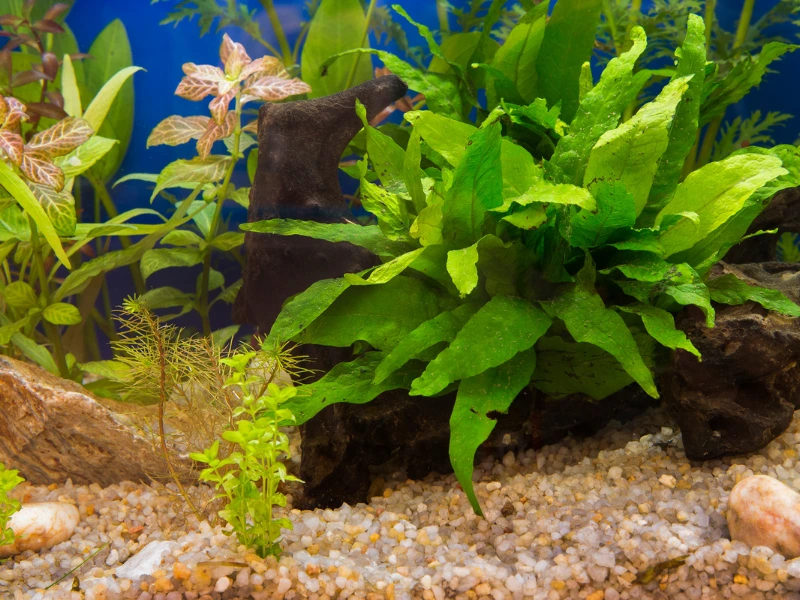
Step 1: Choosing the Right Aquatic Plants
Picking the right plants for your aquarium is just like choosing plants for your garden—some thrive in full sun with rich soil, while others prefer shade and minimal care. The same goes for aquatic plants! Some need high light and CO₂ injection to flourish, while others are perfectly happy in a low-tech setup.
If you’re just starting out, it’s best to go with hardy, low-maintenance plants that can adapt to a variety of conditions.
-
Java Fern (Microsorum pteropus) – Low maintenance, grows well in low light.
-
Anubias – Hardy plant that thrives in most conditions.
-
Amazon Sword (Echinodorus amazonicus) – Perfect for larger tanks.
-
Hornwort – Helps oxygenate the water and prevent algae growth.
-
Java Moss – Ideal for shrimp tanks and low-light setups.
For aquarists who want to take their aquascaping to the next level, there are plants that require a bit more care but reward you with stunning results.
-
Rotala Rotundifolia – Beautiful red plants that require high light.
-
Monte Carlo – Carpet plants for aquascaping.
-
Dwarf Hairgrass – Great for creating a lush green carpet.
Read more: Enhance Your Aquarium with Marsilea Quadrifolia: The Ultimate Guide
Step 2: Setting Up the Perfect Planted Aquarium
Just like in a garden, plants in your aquarium need the right foundation to grow strong and healthy. This means choosing the best substrate, lighting, CO₂ levels, and filtration to create an environment where they can thrive.
Substrate Matters
Aquatic plants absorb nutrients through their roots, so a nutrient-rich substrate is essential—think of it as the soil for your underwater garden! Some of the best choices include ADA Amazonia, Fluval Stratum, and Eco-Complete, all of which provide essential nutrients for plant growth. If you’re considering using plain gravel or sand, keep in mind that they lack nutrients, so you’ll need to supplement with root tabs to keep your plants happy.
Lighting Requirements
Since plants rely on photosynthesis, proper lighting is crucial for their survival. The amount of light your plants need depends on their type:
-
Low light plants (like Java Fern and Anubias) need about 6-8 hours per day.
-
Medium light plants (such as Amazon Sword and Cryptocoryne) do best with 8-10 hours per day.
-
High light plants (like Rotala and Monte Carlo) require 10-12 hours per day to maintain their vibrant colors and fast growth.
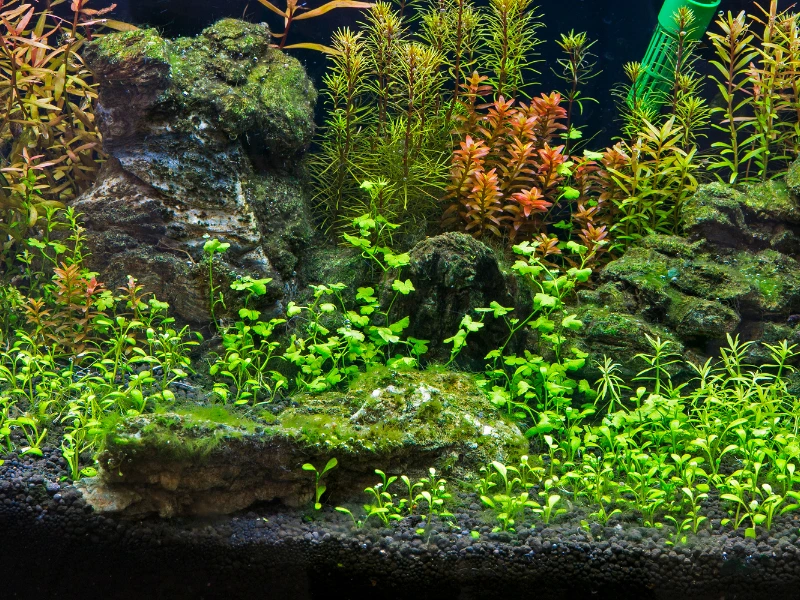
For the best results, LED aquarium lights are the top choice since they provide full-spectrum lighting while being energy-efficient. Some of the best options include Finnex Planted+ 24/7, NICREW SkyLED, and Fluval Plant 3.0, all of which are highly rated for growing lush, healthy plants.
Do You Need CO₂ Injection?
CO₂ is like the fertilizer of the underwater world—plants use it for photosynthesis, and the more they get, the faster and healthier they grow. However, not all setups require CO₂ injection.
-
Low-tech tanks (with hardy plants like Java Fern and Anubias) can thrive without additional CO₂.
-
High-tech tanks (with demanding plants like Rotala or Monte Carlo) benefit from pressurized CO₂ injection to support their rapid growth and vibrant colors.
If you’re adding CO₂, using a drop checker can help you monitor levels to ensure your plants get just the right amount without harming your fish.
Filtration & Water Flow
Aquatic plants love gentle, steady water movement—it helps distribute nutrients while preventing debris buildup. The type of filter you choose depends on your tank setup:
-
Sponge filters are perfect for shrimp and betta tanks, as they provide filtration without creating strong currents.
-
Canister filters are excellent for larger, heavily planted tanks, offering powerful filtration while keeping the water clear.
Step 3: Fertilizing Your Aquarium Plants
Just like garden plants need compost or fertilizer to thrive, your aquatic plants require essential nutrients to grow strong and healthy. They need both macronutrients (NPK: nitrogen, phosphorus, potassium) and micronutrients (iron, magnesium, calcium) to stay lush and vibrant. Without these, plants may develop yellowing leaves, slow growth, or even start melting away.
Types of Fertilizers
-
Liquid fertilizers (like Seachem Flourish) are great for plants that absorb nutrients from the water column, such as Java Fern, Anubias, and Hornwort.
-
Root tabs (API Root Tabs) are best for root-feeding plants like Amazon Swords and Cryptocorynes, providing nutrients directly to their roots.
-
DIY fertilizers using dry fertilizers (such as EI dosing method) allow experienced aquarists to fine-tune nutrient levels for optimal plant growth.
Step 4: Preventing Common Plant Problems
Even the best-kept gardens have their challenges, and your planted aquarium is no different! If your aquatic plants aren’t looking their best, don’t worry—most issues are easy to fix with a little troubleshooting.
1. Algae Growth
Algae can be a real nuisance, but it’s often a sign of an imbalance in your tank.
-
Too much light? Try reducing the photoperiod to 6-8 hours per day.
-
Excess nutrients? Adjust your fertilization routine to prevent overfeeding the algae.
-
No CO₂? Increasing CO₂ levels can help plants outcompete algae for nutrients.
2. Yellow or Brown Leaves
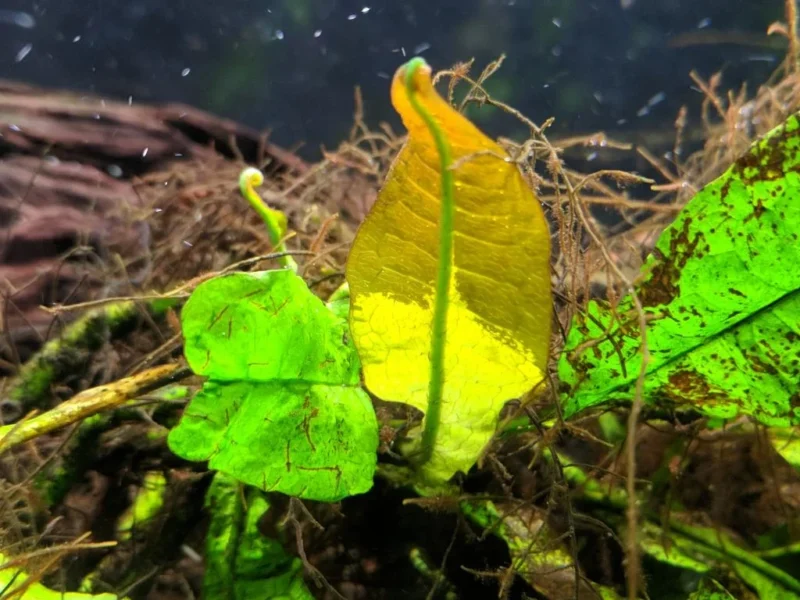
If your plants are losing their vibrant green color, they might be missing key nutrients.
-
Nutrient deficiency? Add fertilizers containing iron, potassium, and micronutrients.
-
Low CO₂? Increasing CO₂ injection can improve plant health.
-
Old leaves? It’s normal for older leaves to die off—just trim them to keep the plant focused on new growth.
3. Melting Plants
Some plants, especially Cryptocorynes, tend to “melt” when introduced to a new environment.
-
Crypt melt? Be patient—these plants usually recover and grow back stronger.
-
Sudden changes? If plants are struggling after a water parameter shift, make adjustments gradually to prevent shock.
Step 5: Pruning & Maintenance
Keeping your plants healthy doesn’t take much effort, but regular maintenance is key.
-
Trim dead or decaying leaves to prevent waste buildup in the tank.
-
Replant stem cuttings to encourage bushier, fuller growth.
-
Perform weekly 20-30% water changes to keep nutrients balanced and algae under control.
FAQ – Your Aquarium Plants Questions Answered!
1. Can I grow aquarium plants without CO₂?
Absolutely! Many hardy plants, like Anubias, Java Fern, and Amazon Sword, thrive in low-tech tanks without CO₂ injection. They grow a bit slower, but they’ll still look great and keep your tank healthy.
2. How do I stop algae from growing on my plants?
Algae can be stubborn, but a few tweaks can help keep it under control:
-
Reduce light exposure by limiting your photoperiod to 6-8 hours per day.
-
Increase CO₂ and nutrients to help plants outcompete algae.
-
Add algae-eaters like Amano shrimp or Otocinclus catfish to help clean up naturally.
3. What’s the easiest aquatic plant to grow?
Java Fern and Anubias are nearly indestructible! They grow well in low light, don’t need CO₂, and require very little maintenance—perfect for beginners.
4. How often should I fertilize my plants?
-
Liquid fertilizers – Apply 2-3 times a week for water column feeders.
-
Root tabs – Replace every 2-3 months for root-feeding plants.
Final Thoughts
Taking care of aquatic plants might seem complicated at first, but once you understand the basics, it becomes effortless and rewarding.
Start with easy plants, choose the right lighting and substrate, and make small adjustments over time. Before you know it, your aquatic garden will be thriving!
Want more aquarium tips? Subscribe for more expert aquascaping guides!

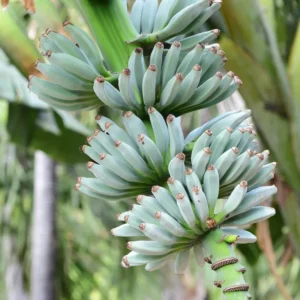 Ice Cream Banana Tree, Blue Java Banana, 4-6" Bareroot Live Plant - Vanilla Flavor Bananas - USDA Zones 8-11
Ice Cream Banana Tree, Blue Java Banana, 4-6" Bareroot Live Plant - Vanilla Flavor Bananas - USDA Zones 8-11  Wonderful Pomegranate Tree Live Plant - 10 to 12 Inches Tall, Pomegranate Fruit Tree or Bush, Perfect for Indoor or Outdoor Growing
Wonderful Pomegranate Tree Live Plant - 10 to 12 Inches Tall, Pomegranate Fruit Tree or Bush, Perfect for Indoor or Outdoor Growing 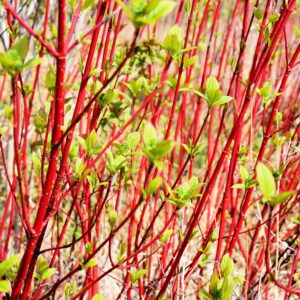 Red Twig Dogwood Shrub Tree, Twig Dogwood Bushes Live Plant, Bare Root, 8-16 Inc Liners, Dormant in Winter
Red Twig Dogwood Shrub Tree, Twig Dogwood Bushes Live Plant, Bare Root, 8-16 Inc Liners, Dormant in Winter 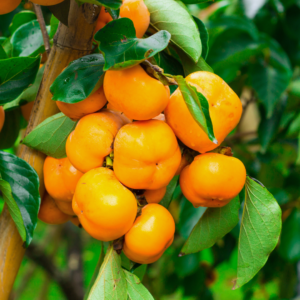 American Persimmon Tree Live Plant - 10 to 12 Inch Tall, Persimmon Fruit Tree for Planting, Hardy and Well-Rooted
American Persimmon Tree Live Plant - 10 to 12 Inch Tall, Persimmon Fruit Tree for Planting, Hardy and Well-Rooted 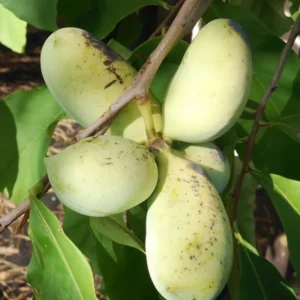 Paw Paw Tree Seedlings, Asimina Triloba Tree 1 Year Old, Well Rooted, Common Pawpaw Tree Live Plant, 6 to 14 Inc Tall
Paw Paw Tree Seedlings, Asimina Triloba Tree 1 Year Old, Well Rooted, Common Pawpaw Tree Live Plant, 6 to 14 Inc Tall 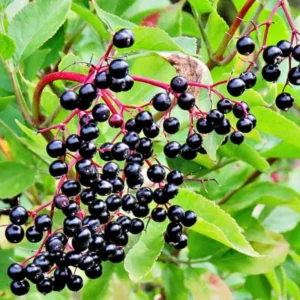 American Elderberry Bush, 6-12 Inch Tall, Black Elderberry Plant High Yielding, Hardy Fruit Plants
American Elderberry Bush, 6-12 Inch Tall, Black Elderberry Plant High Yielding, Hardy Fruit Plants 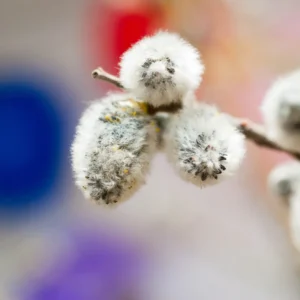 2 Trees Black Willow Live Plants, Hardy Willow Sapling for Landscaping or Bonsai Tree
2 Trees Black Willow Live Plants, Hardy Willow Sapling for Landscaping or Bonsai Tree 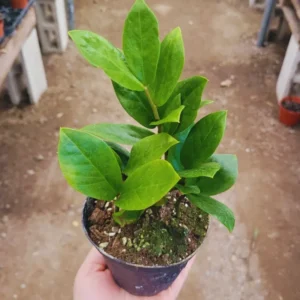 ZZ Plant Tree Live Zamioculcas Zamiifolia Plant - 4 Inch Pot - 4-6 Inches Tall
ZZ Plant Tree Live Zamioculcas Zamiifolia Plant - 4 Inch Pot - 4-6 Inches Tall 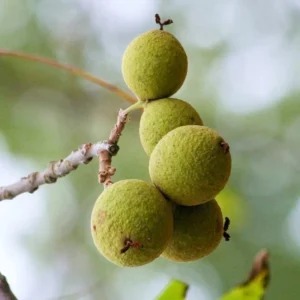 Set 2 Black Walnut Trees Seedlings Live Plants, Black Walnut Tree Sapling, Hardy Walnut for Gardens, Bare Root, 8 to 16 Inc Tall, No Leaf
Set 2 Black Walnut Trees Seedlings Live Plants, Black Walnut Tree Sapling, Hardy Walnut for Gardens, Bare Root, 8 to 16 Inc Tall, No Leaf 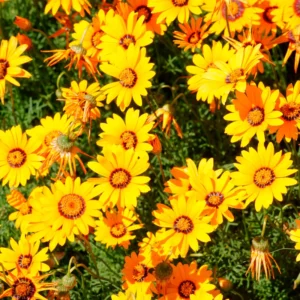 Yellow Coreopsis Live Plant, Tickseed Coreopsis Flowers Perennial, In 4 Inch Pot, Coreopsis Plant Live For Planting
Yellow Coreopsis Live Plant, Tickseed Coreopsis Flowers Perennial, In 4 Inch Pot, Coreopsis Plant Live For Planting 


